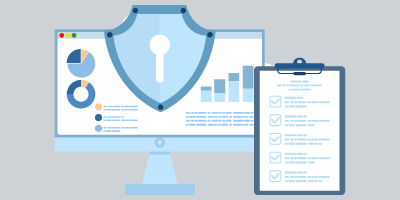Along with a strong cybersecurity infrastructure, it’s critical for organizations to have well-planned physical security measures put in place to help protect onsite information such as data centers, networks, servers, and more from threats. In this video and blog post, we discuss the key components of physical security and how your organization can incorporate these strategic measures into your security program.
What is Physical Security?
Physical security involves protecting your business’ hardware, software, and other forms of data from physical events or threats, such as a natural disaster, burglary, theft, or vandalism, that could lead to significant damage or loss.
Components of Physical Security
Access Control –
Restricting and monitoring access to certain areas, properties, or assets is a key strategy to maximizing physical security. Access control also helps to prevent the exposure of critical data or assets beyond authorized staff. These measures differ from physical barriers in that access control determines who, how and when someone within your organization is given permission to enter a protected site. Physical barriers, such as gates, doors, locks, etc., work to enhance access control and help to physically block or slow a threat actor.
Surveillance –
Choosing strategic locations to install cameras around your building, entry points, or even critical assets can improve your security posture. Surveillance – commonly in the form of closed-circuit television (CCTV) cameras – allows your business to monitor activity across your premises. These surveillance cameras are a useful physical security measure because they can alert personnel to suspicious behavior, or in the event of an attack, help identify the criminal and gather evidence.
Another advantage of physical security components such as surveillance cameras, access controls, and security signs is that these measures can also act as visual deterrents for potential attackers, including cybercriminals.
Physical Security Measures for Businesses & Employees
Hold trainings
Launch access controls across entry points
Wear an ID badge
Report suspicious activity in a timely manner
Test your disaster relief plans
Physical security readiness also means that your business should be prepared to cope with natural disasters such as floods, fires, and storms, among others. Your business should actively coordinate and test your Disaster Relief/Business Continuity plan to ensure you have the right strategies in place to respond to and mitigate a threat.
Key Takeaway
Physical security measures, including surveillance and access control points, are essential to protect your business’ assets and personnel. These measures, when planned and implemented correctly, can help minimize the risk of a breach by making it harder for criminals to access protected sites or data. By investing in good physical security infrastructure, you can reduce the chances of damage to your property and consequential financial strain, as well as ensure the safety of your assets and resources.
Need Assistance with Securing Your Organization’s Assets?
GraVoc provides expert Information Security services including Governance, Risk and Compliance (GRC) and Penetration Testing Services to businesses nationwide. Click the buttons below to learn more about our services.
Related articles
Business Email Compromise: Top BEC Tactics & How to Protect Against Them
We take a look at Business Email Compromise, including common BEC tactics and what your business can do to protect against them.
FFIEC CAT Sunset: Why the CRI Profile is a Strong Alternative
With the FFIEC CAT sunset approaching, we explore why the CRI Profile is a strong alternative to the CAT for financial institutions!
FTC Safeguards Rule Compliance for Auto Dealerships
We’ll go over the FTC Safeguards Rule, what it requires, and how a managed service provider can help auto dealerships stay compliant.




